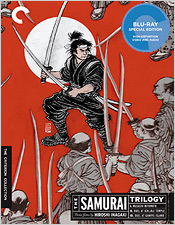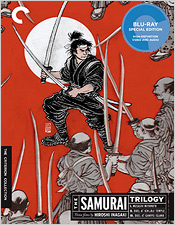Samurai Trilogy, The (Blu-ray Review)

Director
Hiroshi InagakiRelease Date(s)
1954-56 (June 26, 2012)Studio(s)
Toho Company (Criterion - Spines #14, 15 & 16)- Film/Program Grade: A
- Video Grade: A+
- Audio Grade: A-
- Extras Grade: B+
Review
In my heart of hearts, there is no better genre than that of the “samurai film.” As a kid, I’d talk all my friends out of being cops and robbers, cowboys and Indians, or superheroes, and into acting like samurai warriors. We’d get sticks and have sword fights, dress in full black, and run around the woods hunting each other down like dogs. Of course, it missed the whole point of being a samurai but, I still had a pretty good childhood.
My first experience with the samurai film genre was Star Wars. Of course, I didn’t quite grasp at the time just how much Star Wars was influenced by the samurai film genre, but looking back on it with scholarly eyes, I’d have to say that it’s a fair summation – even more now that Lucas gave us the Prequel Trilogy. Right from the start, I dug the whole honorable sword fight thing. Because of Star Wars I’d go to my local video store with my parents (yes, those used to exist) and ask the clerk for sword fight movies. I remember being given Seven Samurai and simply falling in love with it. I couldn’t stop watching it. I asked for it so much, the video store owner ended up giving me a copy on my birthday. Through Seven Samurai, I was turned onto all the other Kurosawa samurai films: Yojimbo, The Hidden Fortress (the film upon which Star Wars is very loosely based – a connection, even as a child I caught) and Sanjuro. Yeah, like I said, I had a good childhood. I was weird, but I had great taste in films.
My father didn’t quite know what to think of me watching movies I had to read. But one time, after he watched Yojimbo together, he went out and rented Fistful of Dollars for me. He didn’t say anything about the connection – but I caught it, and from that point on, I was equally into spaghetti westerns. Those Kurosawa samurai films were the only ones available to me as a kid, but they were a gateway drug. As I grew older, and my passion for the genre grew with me, I sought more and more titles. Over the years, I’ve dug up The Sleepy Eyes of Death, Lone Wolf and Cub, and the Zatoichi series just to name a few of the better known one. And to this very day, I still watch every new samurai film with the same child-like passion and will preach the gospel of Kurosawa to anyone who is willing to listen.
So with all that personal history, it’s my great pleasure to introduce you to a series of films that are very dear to me, The Samurai Trilogy. And, except for the fact that you have to “read” them, The Samurai Trilogy is very much like a series of classic American costume dramas from the classic days of Golden Hollywood. They are very watchable, very understandable, and very, very entertaining. It’s a series based on the book Musashi Miyamoto, which has been called the Japanese Gone with the Wind – a comparison that, although true based on popularity and sheer scale, seems unfair, mainly because I’m not a big fan of Gone with the Wind.
Musashi Miyamoto was a real historical person. He was a master swordsman, philosopher, and painter. Miyamoto was a well-regarded man through his life, and after his death. Even today, many business students follow his writings (most notably Gorin No Sho – a.k.a. The Book of the Five Rings). But so what? Do the films deliver? Oh, you betcha.
First know, The Samurai Trilogy of films (Samurai I: Musashi Miyamoto, Samurai II: Duel at Ichijoji Temple and Samurai III: Duel on Ganryu Island) aren’t from Kurosawa – but that’s okay. The director is Hiroshi Inagaki, who went on direct two other samurai masterpieces, Chushingura (1962) and Samurai Banners (1969). The films follow Miyamoto from being a young ballsy kid, up to his early retirement (which he eventually left retirement to do battle once more), all along the way, battling those who stand before him. The first of the films starts with Miyamoto as a young man (then known as Takezo), who goes off to fight in the Japanese civil war, around 1600. He survives his first battle, but he and his friend are both hurt and tired, so they take up refuge with a woman and her daughter, and things kind of start there for Takezo. You have to pay attention, because virtually all of the characters introduced in the first film will follow Takezo through the later films in various ways. To go too much into story, would be a disservice to the films themselves – they really should be watched by all fans of big epic movie-making. Suffice it to say, Takezo goes from head strong young man, to brute thug, to enlightened Buddhist, to an undefeated warrior, and eventually to content farmer. It takes three films, and a little over 5 hours to tell this story. But, what a story.
The cast of characters are all intriguing and well-drawn. From the women who love him, the Buddhist priest who teaches him the road to enlightenment, and his young student in the final film, you will feel like you will know each and every one of them. Even though I have never read the book these films were based on, the entire film plays out like a beautiful novel. It also helps that Takezo is played by Toshiro Mifune, one of my top three favorite actors of all time (Robert Shaw and Chow Yun-Fat are my other two, if you care). His acting is so good here – he goes through such a range, it’s a marvel to behold. Mifune was just so damn good at what he did. God bless him.
Of course, samurai films wouldn’t be anything without sword fights, and there are some great ones in this series. The first film has plenty of battles, often with a great number of people involved in each. The second film opens with a bang, as Takezo battles a warrior armed with a chain and sickle, and it just gets better from there. The series ends with a battle featuring Takezo, against his long-time fan and biggest rival, Sasaki Kojiro, on the beach of Ganryu, a rivalry that grows out of the second film. The final battle, even if it’s not as elaborate as the others, is breathtaking, mainly because it’s the last one, and the angel of death hovers so close to our main character.
I think The Samurai Trilogy is a very important set of films, and they work so well on a great many levels. I’d like to see more people fall in love with these films.
As they stand on the new Blu-ray upgrade from the previous Criterion DVD release, this trilogy looks and sounds about as wonderful as any film could look. Presented in 1080p in its original 1.33:1 aspect ratio – this presentation will make you cry. It’s so lovely, watching this Blu-ray is like watching the films for the very first time. The color is gorgeous overall, which is a nice comparative jump up from the previous Criterion DVD release which had a slightly off, processed look overall. The audio is in the original Japanese in a linear PCM, uncompressed mono format, and sounds mighty fine – no problems there. With three great films on one set, you can’t expect too much supplemental material, and for what we got in the previous release, we get quite a bit more. This time around, we get a beautiful twenty-four-page booklet instead of a pamphlet with essays from Japanese film expert Stephen Prince (about the film) and Miyamoto historian William Scott Wilson (on Miyamoto’s Book of the Five Rings), a three-part video where Wilson talks about the actual Musashi Miyamoto and gives a bit of background on Yoshikawa’s novel as well as the collection film trailers from all three films that was originally on the DVD set. All in all, Criterion gives us a truly great package for this trio of films.
If you get the chance, check out some cool, early samurai flicks outside of the Kurosawa gallery. The Samurai Trilogy is a good place as any to start if you’re unfamiliar with the genre. These films are chock full of great actors, wonderful storylines, and pack enough thrills to entertain many modern day film fans – and this new Blu-ray set real sells these films.
- Todd Doogan

